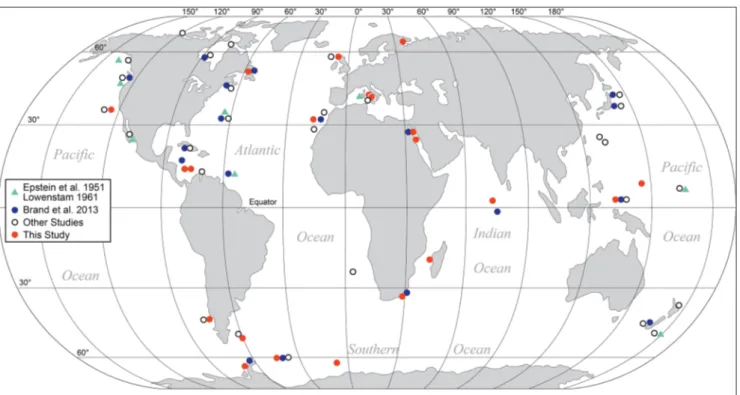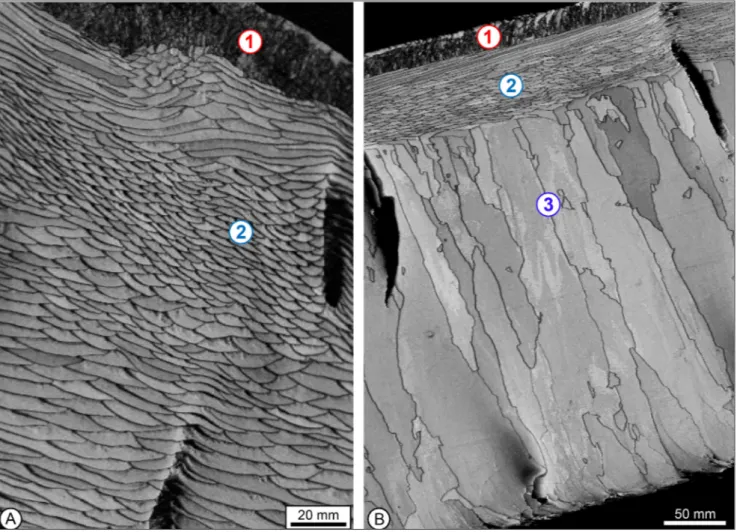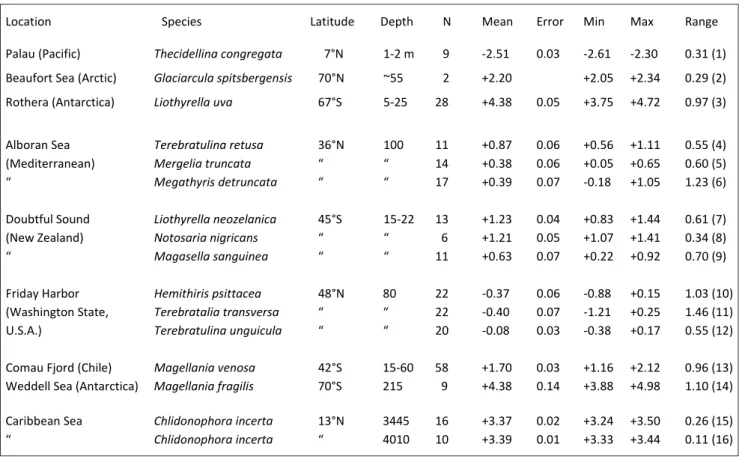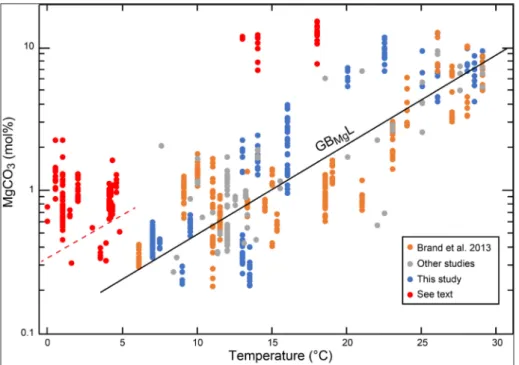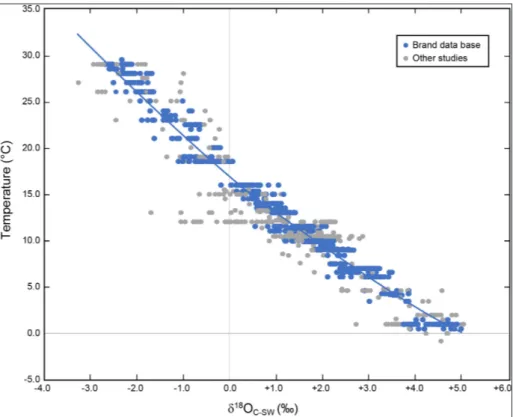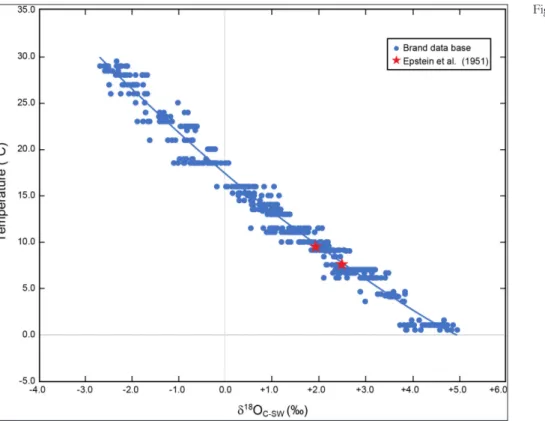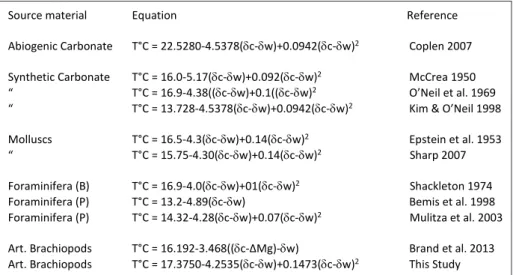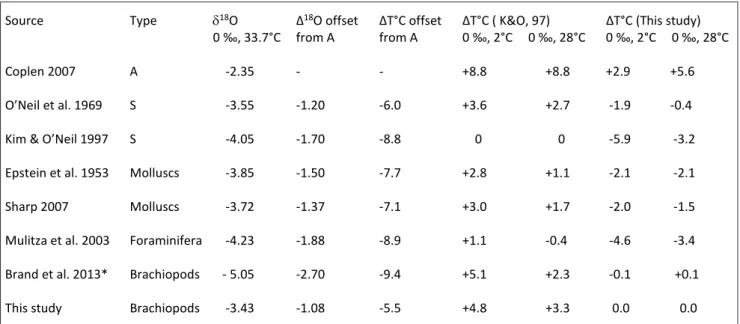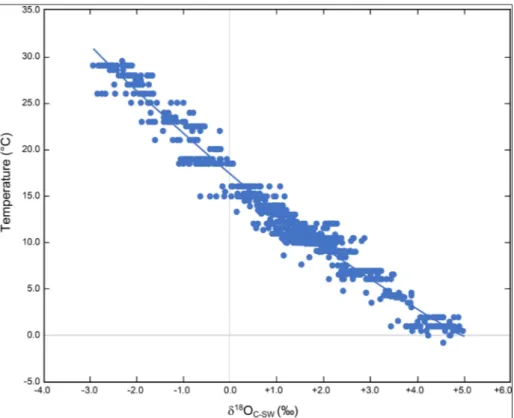BRACHIOPOD-BASED OXYGEN-ISOTOPE THERMOMETER: UPDATE AND REVIEW
UWE BRAND1*, M. ALEKSANDRA BITNER2, ALAN LOGAN3, KAREM AZMY4, GAIA CRIPPA5, LUCIA ANGIOLINI5, PATRICK COLIN6, ERIKA GRIESSHABER7, ELIZABETH M. HARPER8,
EMMA TADDEI RUGGIERO9 & VRENI HÄUSSERMANN10
1*Corresponding author: Department of Earth Sciences, Brock University, 1812 Sir Isaac Brock Way, St. Catharines, Ontario L2S3A1 Canada. E-mail: [email protected]
2Institute of Paleobiology, Polish Academy of Science, Twarda 51/55, 00-818 Warsaw, Poland
3Centre for Coastal Studies, University of New Brunswick, Saint John, New Brunswick E2L 4L5, Canada
4Department of Earth Sciences, Memorial University of Newfoundland, St. John’s, Newfoundland A1B3X5, Canada 5Dipartimento di Scienze della Terra “A. Desio”, Università degli Studio di Milano, Via Mangiagalli 34, 20133 Milano, Italy 6Coral Reef Research Foundation, P.O. Box 1765, Koror 96940, Palau
7Department of Earth and Environmental Sciences, Ludwig-Maximilians-Universität München, Theresienstr. 41, 80333 Munich, Germany 8Department of Earth Sciences, University of Cambridge, Cambridge, U.K.
9Dipartimento di Scienze della Terra, Università di Napoli Federico II, 801380 Napoli, Italy
10Pontificia Universidad Católica de Valparaíso, Facultad de Recursos Naturales, Escuela de Ciencias del Mar, Avenida Brasil, 2950, Valparaíso, Chile & Huinay Scientific Field Station, Puerto Montt, Chile
To cite this article: Brand U., Bitner M.A., Logan A., Azmy K., Crippa G., Angiolini L., Colin P., Griesshaber E., Harper E.M., Taddei Ruggiero E. & Häussermann V. (2019) - Brachiopod-based oxygen-isotope thermometer: update and review. Riv. It. Paleont. Strat., 125(3): 775-787.
Abstract. In the early 1950’s, McCrea and Epstein and co-workers laid the foundation for the oxygen isotope-based thermometers. Many variations of the thermometer have been since formulated isotope-based on synthetic and bioge-nic carbonates. Overall, the use and application of oxygen isotope thermometers must consider and be specific as to the mineralogy, and whether it is synthetic, abiogenic or biogenic carbonate.
Here, we propose an updated and refined oxygen-isotope thermometer based on a large database of articula-ted brachiopods from high to low latitudes, cold to warm and shallow to deep-water regimes. In general, brachiopod-based oxygen isotopes are offset from abiogenic calcite precipitated in thermodynamic equilibrium by about -1 ‰. They maintain this offset and that allows for the determination of robust ambient water temperatures over the full marine spectrum. Thus, the specific brachiopod-based oxygen-isotope thermometer applies, with few exceptions, to most modern articulated brachiopods, and potentially their ancient counterparts, and it is as follows:
T°C =17.3750 – 4.2535 (δc-δw) + 0.1473 (δc-δw)2 (N=578, r2 = 0.980)
Furthermore, it is imperative that mineralogy and taxa be considered for their appropriateness in the appli-cation of oxygen isotope thermometers on synthetic, abiogenic and biogenic marine carbonates. Articulated bra-chiopods are ideal recorders of oceanographic parameters due to their sessile nature, widespread distribution, high abundance in the Paleozoic and Mesozoic, high resilience to most environmental stresses (e.g., climate change - global warming, ocean acidification), and the resistance of the calcite shell – the archive – to post-depositional diagenetic alteration.
Received: April 15, 2019; accepted: October 04, 2019
I
ntroductIonIn 1950, McCrea published a paper on the first oxygen isotope - water temperature relation-ship based on synthetically precipitated calcite. The idea followed the natural progressing of the prin-ciples on stable isotope geochemistry outlined by Urey (1947). His study was followed in quick suc-cession by the paper of Epstein et al. (1951) and the presentation of another oxygen isotope thermom-eter, but this one was based on well-constrained biogenic carbonates and their ambient seawater temperatures. This study included brachiopods, bivalves, and gastropods from environments with detailed information of water temperature and oxy-gen isotope composition. In their follow-up study (Epstein et al. 1953), the authors dropped the bra-chiopods from their investigation of marine bio-genic carbonates, instead relying mostly on mollusc material. It was not until the 1980’s, when the study by Lowenstam (1961) on modern brachiopods and their shell geochemistry sparked renewed interest in this group of marine organisms (Morrison & Brand 1986). He proposed that brachiopods incorporate oxygen isotopes into shell carbonate in equilibrium with ambient seawater. Subsequently, it was realized that there may be differences in carbon and oxygen isotope compositions between aragonite and calcite (e.g., Tarutani et al. 1969), as well as some potential for a vital effect in their compositions in biogenic carbonates (e.g., Wefer 1985).
The paper by Carpenter & Lohmann (1995) initiated a second resurgence in the geochemical study of brachiopods, but they advocated caution about the suitability of some of their shell com-ponents such as the primary layer as a reliable re-corder of ambient environmental conditions. This resurgence continues unabated to this day, with comprehensive geochemical works, just to name a few, for example, Buening & Carlson (1992), Buen-ing & Spero (1996), Auclair et al. (2003), Brand et al. (2003, 2013, 2015), Parkinson et al. (2005), Cusack et al. (2008), Perez-Huerta et al. (2008), Yamamoto et al. (2010), Takayanagi et al. (2013), Came et al. (2017), Ullmann et al. (2017a, 2017b), and Bajnai et al. (2018). Unfortunately, these and many other studies did not resolve the issue of whether articu-lated brachiopods incorporate carbon and oxygen isotopes in equilibrium or not with ambient seawa-ter. Instead, it is becoming increasingly clear that
thermodynamic equilibrium is not the norm for ox-ygen and clumped isotope incorporation into mod-ern brachiopod calcite shells (Bajnai et al. 2018) and potentially other biogenic carbonates (e.g., Erez & Luz 1983; McConnaughey 2003).
Despite the on-going issue of whether arti-culated brachiopods precipitate their calcite shells in thermodynamic equilibrium or not, they are un-surpassed marine-water temperature recorders be-cause their history extends back to the Cambrian, and they occur in all depth and temperature regi-mes of mostly normal marine salinity. Furthermore, their sessile nature and diagenetically resistant low-Mg calcite mineralogy make them ideal archives of recording and storing information about spatially-fixed but temporally changing oceanographic con-ditions. With a change in oceanographic conditions, marine organisms must either migrate to a more favourable location, adapt to the changing envi-ronmental conditions or become extinct. It appears that brachiopods, as a group, are quite resilient in coping with environmental changes such as mode-rate (Peck et al. 2009) but not excessive increases in water temperature (e.g., Brand et al. 2012, 2016) or ocean acidification (Cross et al. 2018). Thus bra-chiopods, a group of marine invertebrates able to survive mass and smaller extinctions, are invaluable in recording changes in past and present oceano-graphic conditions.
The objective of this study is a re-evaluation of the applicability of low-Mg calcite articulated brachiopod shells as archives of oxygen isotope and thus of ambient water temperatures (Epstein et al. 1951, 1953; Brand et al. 2013). This evaluation and review are important in light of the fact that brachiopods, apparently do not incorporate oxygen and clumped isotopes in thermodynamic equili-brium with ambient seawater (Bajnai et al. 2018). We aim to quantify this offset and formulate a rela-tionship that allows for the calibration of ambient seawater temperatures using modern articulated brachiopods.
S
tudyM
aterIal andM
ethodSThe study material consists of modern ar-ticulated and some inarar-ticulated brachiopods and their ambient seawater. In addition, presentations and evaluations will consider the results of the
pre-vious study by Brand et al. (2013) and the results of others contained therein. Furthermore, studies of other authors published since 2013 will be also con-sidered in this evaluation (e.g., Ullmann et al. 2017a, 2017b; Bajnai et al. 2018).
Modern Brachiopods
This study consists of a total of 164 spe-cimens belonging to 17 species from 22 localities covering high to low latitudes, from cold to warm, and from shallow to deep depths for geochemical evaluation (Fig. 1). With ontogenetic sampling, the geochemical results include 328 MgCO3 determina-tions, which include 26 results of the inarticulated brachiopod Novocrania anomala from the
Mediterra-nean, whereas the total oxygen isotope results num-ber 324 analyses from all shell layers/areas (except for the primary layer; Supplement 1).
Modern Seawater
In conjunction with the brachiopods, whene-ver feasible, we collected seawater for isotope and chemical analyses to complement the shell chemi-stry. For some select localities such as Signy Island (Antarctica), the Weddell Sea (Antarctica) or off California (U.S.A.), we had to rely on information from published sources (Marshall et al. 1997; Pierre
1999; Bigg & Rohling 2000; Mackensen 2001; Bass et al. 2014; Supplement 2).
Analytical Methods - Sample Preparation
All brachiopod shells were cleaned of organic tissue by physical and chemical means (cf. Brand et al. 2003; Zaky et al. 2015). All sufficiently large spe-cimens were sampled along the ontogenetic growth axis – from the umbo to the shell edge (cf. Romanin et al. 2018). For small specimen, we had to use the whole shell for trace chemistry and stable isotope analyses. Prior to powdering and/or milling, the pri-mary layer, as much as possible, was physically and chemically removed from the underlying layer(s) by leaching shells with 10 % hydrochloric acid. In ad-dition, specialized areas, such as umbo and muscle scars were sampled separately for individual analysis and evaluation.
Analytical Methods - Sample Imaging
EBSD (electron backscatter diffraction) ima-ging of the modern brachiopods was carried out on a Hitachi SU 5000 field emission scanning electron microscope (SEM) equipped with an Oxford de-tector. The instrument was operated at 20kV and measurements were indexed with the CHANNEL 5 HKL software.
Fig. 1 - Localities of modern articulated brachiopods examined in this study (Supplement 1) and of other studies mentioned in Brand et al. (2013), for example Lowenstam (1961) and of Epstein et al. (1951). Seawater information and chemistry are presented in Supplement 2.
Analytical Methods - Elemental chemistry
Most samples were analysed for Ca, Mg, Sr, Na, Mn and Fe by atomic absorption spectrometer; but, here we report only on the Mg results (Sup-plement 1). All results were adjusted to a 100 % carbonate basis (cf. Brand & Veizer 1980). Repro-ducibility consisting of accuracy and precision of elemental results (Mg) compared to certified NBS (NIST) SRM 633 value was better than ±0.8 and 6.2 %, respectively.
Analytical Methods - Stable Isotopes
All brachiopod powder material was analysed for carbon and oxygen isotope compositions at Me-morial (Canada) and Milan (Italy) Universities. A small quantity of weighed powder was reacted with anhydrous phosphoric acid at 70°C prior to intro-duction into the mass spectrometer. All results are normalized and reported in VPDB in permil (‰). Reproducibility compared to NBS 19 and
IAEA-603 calibrated with internal standards was better than 0.05 ‰. All brachiopod trace chemistry (Mg) and isotope (δ18O) results are reported in Supple-ment 1.
Seawater samples collected in the field were filtered and stored in 50 mL amber borosilicate glass vials. They were kept cool for as long as pos-sible during shipment. Water temperature was mea-sured with a Fish Hawk TD probe on an aliquot of the shipped sample. Salinity was measured imme-diately upon receipt of sample in the lab at Brock University (Canada), which was followed by trace chemistry analysis at Brock on an atomic absorp-tion spectrometer. Seawater oxygen isotope compo-sition was determined by the G.G. Hatch laboratory at the University of Ottawa (Canada) following the procedure and protocol listed in Brand et al. (2013) and reported in VSMOW. Replicate analyses and re-producibility were better than 0.01 ‰, and all geo-chemical results are presented in Supplement 2. Fig. 2 - EBSD band contrast-images of shell microstructures of primary, secondary and tertiary layers in some modern brachiopods. A:
Mi-crostructure of primary (1) and secondary (2) layers within calcite shell of Liothyrella uva. B: Microstructure of primary (1), secondary
r
eSultSShells of the studied articulated brachiopods consist of either a two-layer or three-layer sequen-ce. The outer, primary layer has a microgranular fa-bric, whereas the secondary layer generally consists of elongated mesocrystal fibers, whereas the tertiary layer (if present) consists of prismatic columns (Fig. 2; Garbelli et al. 2012; Schmahl et al. 2012; Casella et al. 2018). In all instances, the outer primary layer was removed prior to elemental and isotope analyses, be-cause of the inherent vital effect recorded by it (cf. Carpenter & Lohmann 1995). Extraction and remo-val of the primary layer must be followed through on fossil material to avoid extraneous signals not repre-sentative of the ambient environment (cf. Brand et al. 2012). It is equally desirable that all fossil material be inspected and tested for preservation of primary values including the brachiopod archive (e.g., Brand 1982, 2004; Popp et al. 1986; Veizer et al. 1999; An-giolini et al. 2012). Because of the many deviations from apparent thermodynamic equilibrium of mari-ne biogenic carbonates, here, we will concentrate on the articulated brachiopods.
e
nvIronMentald
IStrIbutIonThe summary statistics of oxygen isotope composition, corrected for seawater-18O, of mo-dern brachiopods from low to high latitudes, shal-low to deep settings, and changing depths provide insight into the incorporation process. No specific but some general relationships exist between envi-ronmental settings and oxygen isotope composi-tions as well as specimens inhabiting the same envi-ronment (Tab. 1). The δ18O values of brachiopods from the tropics (e.g., Palau) are more negative than those of high latitude counterparts (Beaufort Sea, Rothera [Antarctica]; Tab. 1). However, the values of the two high latitude specimens differ by about 2.1 ‰ reflecting strong isotopic differences betwe-en the waters of the Arctic and Southern Oceans. Low ambient water temperatures are also encounte-red in tropical but abyssal regimes such as the Ca-ribbean (Tab. 1). A comparison of mid-latitude bra-chiopod populations from Friday Harbor (48°N) and Doubtful Sound (45°S), similarily, shows an average difference of about 1.3 ‰ (Tab. 1). Some of the smallest ranges in δ18O values are recorded in
_________________________________________________________________________________________________________________ Location Species Latitude Depth N Mean Error Min Max Range Palau (Pacific) Thecidellina congregata 7°N 1-2 m 9 -2.51 0.03 -2.61 -2.30 0.31 (1) Beaufort Sea (Arctic) Glaciarcula spitsbergensis 70°N ~55 2 +2.20 +2.05 +2.34 0.29 (2) Rothera (Antarctica) Liothyrella uva 67°S 5-25 28 +4.38 0.05 +3.75 +4.72 0.97 (3) Alboran Sea Terebratulina retusa 36°N 100 11 +0.87 0.06 +0.56 +1.11 0.55 (4) (Mediterranean) Mergelia truncata “ “ 14 +0.38 0.06 +0.05 +0.65 0.60 (5)
“ Megathyris detruncata “ “ 17 +0.39 0.07 -0.18 +1.05 1.23 (6)
Doubtful Sound Liothyrella neozelanica 45°S 15-22 13 +1.23 0.04 +0.83 +1.44 0.61 (7) (New Zealand) Notosaria nigricans “ “ 6 +1.21 0.05 +1.07 +1.41 0.34 (8)
“ Magasella sanguinea “ “ 11 +0.63 0.07 +0.22 +0.92 0.70 (9)
Friday Harbor Hemithiris psittacea 48°N 80 22 -0.37 0.06 -0.88 +0.15 1.03 (10) (Washington State, Terebratalia transversa “ “ 22 -0.40 0.07 -1.21 +0.25 1.46 (11) U.S.A.) Terebratulina unguicula “ “ 20 -0.08 0.03 -0.38 +0.17 0.55 (12) Comau Fjord (Chile) Magellania venosa 42°S 15-60 58 +1.70 0.03 +1.16 +2.12 0.96 (13) Weddell Sea (Antarctica) Magellania fragilis 70°S 215 9 +4.38 0.14 +3.88 +4.98 1.10 (14) Caribbean Sea Chlidonophora incerta 13°N 3445 16 +3.37 0.02 +3.24 +3.50 0.26 (15)
“ Chlidonophora incerta “ 4010 10 +3.39 0.01 +3.33 +3.44 0.11 (16)
____________________________________________________________________________________________________________
Tab. 1 - Summary statistics (δ18O ‰, VPDB; seawater-18O corrected values) of select modern articulated brachiopods from low to high lati-tudes, from warm to cold and shallow to deep environmental settings. Note: Number (in brackets) corresponds to numbers in Fig. 3.
both warm and cold water brachiopods, for exam-ple, from Palau, Caribbean Sea, and Beaufort Sea, whereas the opposite of large ranges are recorded
in counterparts from Rothera (Antarctica), Weddell Sea, Alboran (Mediterranean), and Friday Harbor (North Pacific, Washington State, U.S.A.; Fig. 3). Thus, it is quite clear that a simple latitudinal model does not adequately address the isotopic variation recorded by modern brachiopods. Instead, it must give way to a more realistic and complex oceano-graphic relationship (Fig. 3) when dealing with mo-dern and deep-time brachiopods.
Individual brachiopod groups complicate matters, by incorporating and/or growing at diffe-rent times during the year, which is clearly documen-ted by the groups from the Alboran Sea, Doubtful Sound (New Zealand) and Friday Harbor (Tab. 1, Fig. 3). Thus in addition to latitudinal variation(s), environmental assessments must give due consi-deration to species-specific growth conditions (cf. Ullmann et al. 2017a) during isotope evaluations of brachiopods.
M
gco
3contentSandtheg
lobalb
rachIopodM
gl
IneThe Mg content of brachiopods has garnered great interest in being a potential proxy of seasona-lity (Butler et al. 2015; Clark et al. 2016) as well as a water-independent thermometer (e.g., Perez-Huerta et al. 2008). Several concepts need to be considered before we can implement its full potential, such as growth rate, species-specific biomineralization, and Fig. 3 - Absolute δ18O mean values and ranges of modern articulated
brachiopods from low to high latitudes, cold to warm and from shallow to deep environments. For additional details see Tab. 1.
Fig. 4 - Plot of MgCO3 contents of modern brachiopods supple-mented by those of Brand et al. (2013) and of other stud-ies. Samples in ‘red’ symbols and above the dashed line fall outside the expected content and range typical for articulated brachiopods and their concurrence with the ‘Global Brachiopod Mg Line’ (Brand et al. 2013). The ‘red’ specimens include the inarticulated species
Novocrania anomala from the
Mediterranean, and most ar-ticulated brachiopods from environments with ambient water temperatures of less than 5°C (cf. L. notorcadensis, L. uva, M. fragilis, C. incerta,
an appropriate group-specific thermometer. Brand et al. (2013) presented the MgCO3 content of the global population on modern brachiopods (Fig. 4), with most other modern material falling within the parameters of the LINE. Most Mg results of the new brachiopod database also fall within the confi-nes of the LINE; with few exceptions (Fig. 4). The articulated species Liothyrella uva, Liothyrella notor-cadensis (old description => uva), Magellania fragilis, Chlidonophora incerta, and Compsothyris racovitzae, and
the inarticulated Novocrania anomala fall above the
GBMgL (Fig. 4). Based on analogous faster growth of the umbo and its correspondingly higher Mg content it was concluded that faster growth rate due to higher temperatures and/or productivity may be responsible for this ‘positive’ Mg offset (e.g., Bue-ning & Carlson 1992; Perez-Huerta et al. 2008; Brand et al. 2013; Butler et al. 2015). Many modern brachiopods have a life span of 5 -10 years (e.g., Thayer 1977; Baumgarten et al. 2013), with a few such as Liothyrella neozelanica have life spans of about
17 years (Baird et al. 2013). Even fewer such as L. uva and M. fragilis have life spans in excess of 50
years (Brey et al. 1995; Peck & Brey 1996), and with a similar life span observed for the inarticulated
bra-chiopod N. anomala (Taddei Ruggiero 2001). Based
on the observed long life spans, it is not fast growth rate, but indeed the opposite, a ‘slow’ one that is responsible for their ‘positive’ Mg offset from the
GBMgL (Fig. 4). Thus, a re-evaluation of the Mg content for brachiopods, in concert, with this revi-sed thinking is highly warranted for its unrealized potential as a seawater- independent thermometer.
d
IScuSSIonBrachiopod-based oxygen-isotope ther-mometer
For decades, researchers used the Epstein et al. (1953) oxygen-isotope thermometer on various carbonates archives from foraminifera to molluscs to brachiopods. But diversification and the realiza-tion of species influences saw the proliferarealiza-tion of a multitude of paleothermometers; among them syn-thetic (Kim & O’Neil 1997) and biogenic carbona-tes (e.g., Brand et al. 2013). However, the question of equilibrium, more precisely of thermodynamic equilibrium, remains an elusive goal (Bajnai et al. 2018).
The work of Coplen (2007) and Bajnai et al. (2018) on abiogenic and brachiopod calcite clearly highlights the difference in isotopic compositions at perceived slow growth rates. Brand et al. (2013) invoked a Mg-influence on the oxygen isotope com-position and ultimately a relationship to water tem-perature. Since this was based on Mg impacts recor-ded in synthetically precipitated carbonates, another Fig. 5. - Plot of water-corrected
oxygen isotope composi-tions of modern brachio-pods and ambient seawater temperature (this study and Brand et al. 2003, 2013) supplemented by results of other studies (N=1227). Other results from Epstein et al. (1951), Henkes et al. (2013), Came et al. (2014), Rollion-Bard et al. (2016), Wacker et al. (2014), Butler et al. (2015), Ullmann et al. (2017a, 2017b), Bajnai et al. (2018). The results were not filtered for position on the shell, but it excludes results of the primary layer.
way was needed to assess the potential of brachio-pods as robust archives of water temperature. The early results of Epstein et al. (1951) and Lowenstam (1961) were quite promising, but the question of equilibrium in brachiopods essentially remained un-resolved all these decades.
Here, we present an update on this issue with Figure 5, which shows brachiopod oxygen isotope results covering the world’s oceans from all latitu-des, depths, salinity and temperature (Fig. 1). Con-siderable ‘noise’ is evident in the data, because it includes δ18O results from all parts of the brachio-pod shell (dorsal and ventral) from the umbo (po-sterior) to the commissure (anterior), but with one exception. No results from the primary layer were used in the reconstruction of Figure 5, since it has been documented that this layer is definitely in iso-topic disequilibrium (e.g., Carpenter & Lohmann 1995; Auclair et al. 2003; Brand et al. 2003; Par-kinson et al. 2005). Another version of the same database but without results from the umbo area and other undesirable areas (e.g., muscle scars) im-proves the correlation (Fig. 8). However, the best oxygen isotope-temperature relationship is realized when we limit the results to this study, and select ones from the study of Brand et al. (2013; Fig. 6) with ambient seawater temperatures or oxygen iso-tope compositions or both. Following the principle used in formulating the first biogenic
isotope-tem-perature relationship (cf. Epstein et al., 1953), a 2nd order polynomial correlation is highly satisfactory (r2 = 0.980, p < 0.05) for the brachiopod-based re-sults after adjustment for seawater-18O. This newly minted relationship does not require an adjustment for Mg contents or salinity to determine ‘robust’ temperatures of the ambient seawater. Specimens from cold to warm settings give ‘consistent’ tem-peratures in excellent agreement with actual de-positional conditions. Unfortunately, the really slow-growing brachiopod N. anomala could not be
accommodated in this relationship, but due to its extremely slow growth, its oxygen isotope contents and those of other inarticulated brachiopods de-serve further investigation.
Oxygen Thermodynamic Equilibrium
A recent study by Watkins et al. (2013) sugge-sted that oxygen thermodynamic equilibrium was unlikely between calcite and ambient water whether formed in natural settings or precipitated in the la-boratory. This observation was affirmed by Bajnai et al. (2018) who investigated oxygen and clumped isotopes in modern brachiopods. Their conclusions confirmed the statement by Coplen (2007) about a general lack of thermodynamic equilibrium, but instead, suggests that kinetic fractionation may go-vern the oxygen isotope compositions of many marine carbonates.
Fig. 6 - Plot of water-corrected oxy-gen isotope composition of modern brachiopods based solely on the collections of Brand et al. (2003, 2013, 2015) new material collected for this study, and those of Epstein et al. (1951). In ad-dition, it excludes all results from the umbo and other parts of the shell deemed unsuitable for producing reliable and robust tempera-ture determinations (cf. Fig. 8; Carpenter & Lohmann 1995; Parkinson et al. 2005; Brand et al. 2013).
Comparison of thermometers
The brachiopod-based oxygen-isotope ther-mometer appears to give robust temperatures that mimic the ambient water and thus represent bra-chiopod-based equilibrium (BBE, Fig. 6). It was this general observation of BBE (cf. Epstein et al. 1951; Lowenstam 1961) that is the impetus for the re-evaluation of brachiopod oxygen isotope compositions and their fidelity in producing relia-ble paleo-temperatures. Over the years, a number of oxygen-isotope thermometers have been con-structed for various synthetic, abiogenic and bio-genic carbonates, and a small subset is presented in Table 2. Comparison of the various thermome-ters shows general similarities in the slope, with few exceptions, but they differ significantly in their intercept values (Tab. 2, Fig. 7). For many years, the oxygen isotope thermometer of Kim & O’Neil (1997) was regarded as the one closest to repre-senting equilibrium conditions and was extensively used to determine water temperatures of various marine abiogenic and biogenic carbonates. The work of Coplen (2007) clearly demonstrates that synthetically precipitated laboratory carbonates are anything but equilibrium products, and the follow-up work by Kluge et al. (2014) strongly sfollow-upports thermodynamic equilibrium precipitation of the Devils Hole cave (southcentral Nevada) abiogenic carbonates (mammillary vein calcite). This further supports the observation that synthetically formed carbonates and their isotope-based thermometers are not suitable alternatives or substitutes for de-termining ambient seawater temperatures of bio-genic marine carbonates (cf. Fig. 7); we discuss this below.
Isotope and temperature offsets
Calculating the isotope and temperature ‘off-sets’ relative to the abiogenic calcite presented by __________________________________________________________________________________
Source material Equation Reference
Abiogenic Carbonate T°C = 22.5280-4.5378(c-w)+0.0942(c-w)2 Coplen 2007 Synthetic Carbonate T°C = 16.0-5.17(c-w)+0.092(c-w)2 McCrea 1950 “ T°C = 16.9-4.38((c-w)+0.1((c-w)2 O’Neil et al. 1969 “ T°C = 13.728-4.5378(c-w)+0.0942(c-w)2 Kim & O’Neil 1998 Molluscs T°C = 16.5-4.3(c-w)+0.14(c-w)2 Epstein et al. 1953 “ T°C = 15.75-4.30(c-w)+0.14(c-w)2 Sharp 2007 Foraminifera (B) T°C = 16.9-4.0(c-w)+01(c-w)2 Shackleton 1974 Foraminifera (P) T°C = 13.2-4.89(c-w) Bemis et al. 1998 Foraminifera (P) T°C = 14.32-4.28(c-w)+0.07(c-w)2 Mulitza et al. 2003 Art. Brachiopods T°C = 16.192-3.468((c-∆Mg)-w) Brand et al. 2013 Art. Brachiopods T°C = 17.3750-4.2535(c-w)+0.1473(c-w)2 This Study Note: c - 18O ‰ (PDB) of carbonate, w - 18O ‰ (SMOW) of seawater/water, ∆Mg – mol % of MgCO3; (B) – benthic, (P) – planktonic; Art. - articulated
Tab. 2 - Compilation of some se-lect oxygen-isotope based temperature equations for various abiogenic, synthetic and biogenic carbonates. Note: δc-δ18O ‰ (PDB) of carbonate, δw-δ18O ‰ (SMOW) of seawater/water, ∆Mg – mol % of MgCO 3 ; (B) – benthic, (P) – plankto-nic; Art. - articulated
Fig. 7 - Plot of regression lines computed for a number of temper-ature-oxygen isotope relationships of abiogenic, synthetic and brachiopod-based data. The regression for the abiogen-ic carbonate of Coplen (2007) is extrapolated from its sin-gular datum point and the similar precipitation conditions, such as no change with rate, noted for synthetic carbonates (Kim & O’Neil 1997; Coplen 2007, fig. 3). Dashed lines rep-resent extrapolations/extensions of actual data covering the regression lines.
Coplen (2007) from Devils Hole, Nevada, clearly shows the importance of mineralogy and taxa in temperature determinations (Tab. 3). The ∆18O offset varies from a low of -1.08 ‰ to a high of -2.70 ‰, with corresponding offsets in their tem-peratures ranging from a low of -5.5° to a high of -9.4°C. These offsets from thermodynamic equi-librium may be quite large when it comes to doc-umenting real-time trends in deep-time and near-time climate change studies based on abiogenic and biogenic carbonates and using the ‘wrong’ oxygen isotope thermometer (Tab. 3). The situation is not much better when using the equation developed by Kim & O’Neil (1997) based on synthetic calcite pre-cipitated under laboratory conditions and generally assumed to give temperature results to be in ‘equi-librium’ with seawater. At seawater temperatures of 2°C and 28°C, the calculated temperatures for bra-chiopods with the Kim & O’Neil (1997) thermom-eter would be underestimated by 4.8° and 3.3°C, respectively (Tab. 3). Similarly, with the isotope thermometer based on articulated brachiopods, cal-culated temperatures for molluscs and foraminifera would be overestimated by about 2° to 4.6°C at the pre-set level of 2°C, and by about 1.5° to 3.4°C at the pre-set level of 28°C (Tab. 3).
These temperature offsets underscore the necessity for giving due consideration to, a) the re-spective mineralogy of biogenic carbonates, b) their taxonomic position (Fig. 7), and c) of using
synthet-ic carbonate-based thermometers. Thus, for tem-perature determinations with biogenic carbonates it is inappropriate to use abiogenic and synthetic car-bonate-based thermometers for paleoenvironmen-tal reconstructions. Equally inappropriate, biogenic carbonate-based thermometers should not be used for synthetic or abiogenic carbonate paleotempera-ture determinations.
c
oncluSIonSA large database of modern brachiopods was re-evaluated for its potential to act as an archive of a reliable oxygen isotope thermometer. This review was necessitated by the observations and conclu-sions of Coplen (2007) and Bajnai et al. (2018) that biogenic carbonates, including articulated brachio-pods, may not precipitate shell calcite in oxygen iso-tope thermodynamic equilibrium.
We report on an expanded database of mo-dern brachiopod calcite and their ambient seawater temperatures and compositions from high to low, warm to cold, and shallow to deep settings. The oxygen-isotope compositions of the brachiopods are offset relative to abiogenic calcite precipitated in thermodynamic equilibrium by about 1 ‰ and rela-tively constant over their marine temperature range. Instead, the oxygen isotopes presented in the upda-ted brachiopod archive and database are in apparent
Source Type 18O ∆18O offset ∆T°C offset ∆T°C ( K&O, 97) ∆T°C (This study)
0 ‰, 33.7°C from A from A 0 ‰, 2°C 0 ‰, 28°C 0 ‰, 2°C 0 ‰, 28°C Coplen 2007 A -2.35 - - +8.8 +8.8 +2.9 +5.6 O’Neil et al. 1969 S -3.55 -1.20 -6.0 +3.6 +2.7 -1.9 -0.4 Kim & O’Neil 1997 S -4.05 -1.70 -8.8 0 0 -5.9 -3.2 Epstein et al. 1953 Molluscs -3.85 -1.50 -7.7 +2.8 +1.1 -2.1 -2.1 Sharp 2007 Molluscs -3.72 -1.37 -7.1 +3.0 +1.7 -2.0 -1.5 Mulitza et al. 2003 Foraminifera -4.23 -1.88 -8.9 +1.1 -0.4 -4.6 -3.4 Brand et al. 2013* Brachiopods - 5.05 -2.70 -9.4 +5.1 +2.3 -0.1 +0.1 This study Brachiopods -3.43 -1.08 -5.5 +4.8 +3.3 0.0 0.0
____________________________________________________________________________________________________________
Tab. 3 - Isotope and temperature offsets determined for some oxygen isotope thermometers (cf. Tab 1) proposed over the years for abiogenic (A), synthetic (S) and biogenic (molluscs, foraminifera, articulated brachiopods) carbonates. Note: *adjustment for Mg content set to 2000 and 16,000 µg/g at 2°C and 28°C, respectively (cf. Brand et al. 2013).
brachiopod-based equilibrium (BBE) with ambient seawater temperatures. Thus, the brachiopod-based oxygen-isotope and water temperature relationship and thermometer is expressed as:
T°C = 17.3750 – 4.2535 (δc-δw) + 0.1473 (δc-δw)2 (N=578, r2 = 0.980)
Since most thermometers are not based on carbonates formed in thermodynamic equilibrium with ambient fluid(s), it is imperative that a chosen thermometer must be compatible with the respec-tive carbonate species under consideration. Thus, the newly-minted brachiopod-based thermometer should be exclusively used for brachiopod-based paleoenvironmental studies and paleotemperature determinations.
Acknowledgements. First, we must thank the editor and
re-viewers for their input on this manuscript. Also, we thank the organi-zers of the 8th International Brachiopod Congress for furthering our understanding of brachiopods in the geologic world with this special issue. We thank A. Brearley, M. Miller, L. Peck (British Antarctic Sur-vey) and D. Henckel (GEOMAR) for providing us with brachiopods and seawater, and we acknowledge A. Rubinson (Brock University) and A. Davis (Brock) for laboratory assistance, M. Lozon (Brock) for drafting the figures, and E. Ferrari (Università di Milano) for techni-cal support with stable isotope analyses. This study was supported by grants to U. Brand (Discovery grant 2015-05282) from the Natural Science & Engineering Research Council of Canada. Samples were collected, in part, with permits issued by the Bureau of Marine Re-sources, Republic of Palau, the Department of Fisheries and Oceans,
Canada, and the Office of Subsecretaria de Pesca (#1742), Chile. This is publication Nr. 169 of the Huinay Scientific Field Station.
RefeRences
Angiolini L., Stephenson M.H., Leng M.J., Jadoul F., Millward D., Aldridge R.J. Andrews J.T., Chenery S. & Williams G. (2012) - Heterogeneity, cyclicity and diagenesis in a Mis-sissippian brachiopod shell of paleoequatorial Britain.
Terra Nova, 24: 16-26.
Auclair A-C., Joachimski M.M. & Lécuyer C. (2003) - Deci-phering kinetic, metabolic and environmental controls on stable isotope fractionations between seawater and the shell of Terebratalia transversa (Brachiopoda). Chem. Geol., 202: 59-78.
Baird M.J., Lee D.E. & Lamare M.D. (2013) - Reproduction and growth of the terebratulid brachiopod Liothyrella neozelanica Thomson, 1918 from Doubtful Sound, New
Zealand. Biol. Bull., 225: 125-136.
Bajnai D., Fiebig J., Tomasovych A., Milner Garcia S., Rollion-Bard C., Raddatz J., Löffler N., Primo-Ramos C. & Brand U. (2018) - Assessing kinetic fractionation in brachiopod calcite using clumped isotopes. Sci. Reports, 8: 533-545.
Bass A.M., Munksgaard N.C., O’Grady D., Williams M.J.M., Bostock H.C., Rintoul S.R. & Bird M.I. (2014) - Continu-ous shipboard measurements of oceanic δ18O, δD and δ13C
DIC along a transect from New Zealand to Antarctica using cavity ring-down isotope spectrometry. J. Mar. Sci.,
137: 21-27.
Baumgarten S., Laudien J., Jantzen C., Häussermann V. & Fös-terra G. (2013) - Population structure, growth and repro-duction of a recent brachiopod from the Chilean fjord region. Mar. Ecol., 35: 401-413.
Fig. 8 - Plot of water-corrected oxy-gen isotope compositions of modern brachiopods. Data-base as in Figure 5 but with removal of results from the umbo, and other specialized areas giving unsuitable val-ues (cf. Carpenter & Lohm-ann 1995; Parkinson et al. 2005; Brand et al. 2015).
Bemis B.E., Spero H.J., Bijma J. & Lea D.W. (1998) - Re-evalu-ation of the oxygen isotopic composition of planktonic foraminifera: experimental results and revised paleotem-perature equations. Paleoceanography, 13: 15-160.
Bigg G.R. & Rohling E.J. (2000) - An oxygen isotope data set for marine waters. J. Geophys. Res., 105: 8527-8535.
Brand U. (1982) - The oxygen and carbon isotope composi-tions of Carboniferous fossil components: seawater ef-fects. Sediment., 29: 139-147.
Brand U. (2004) - Carbon, oxygen and strontium isotopes in Palaeozoic carbonate components: an evaluation of orig-inal seawater-chemistry proxies. Chem. Geol., 204: 23-44.
Brand U. & Veizer J. (1980) - Chemical diagenesis of a multi-component carbonate system-1. Trace elements. J. Sed. Petrol., 50: 1219-1236.
Brand U., Logan A., Hiller N. & Richardson J. (2003) - Geo-chemistry of modern brachiopods: applications and implications for oceanography and paleoceanography.
Chem. Geol., 198: 305-334.
Brand U., Jiang G., Azmy K., Bishop J.W. & Montanez I.P. (2012) - Diagenetic evaluation of a Pennsylvanian car-bonate succession (Bird Spring Formation, Arrow Can-yon, Nevada, U.S.A.) - 1: brachiopod and whole rock comparison. Chem. Geol., 308-309: 26-39.
Brand U., Azmy K., Bitner M.A., Logan A., Zuschin M., Came R. & Ruggiero E. (2013) - Oxygen isotopes and MgCO3 in brachiopod calcite and a new paleotemperature equa-tion. Chem. Geol., 359: 23-31.
Brand U., Azmy K., Griesshaber E., Bitner M.A., Logan A., Zuschin M., Ruggiero E. & Coli P.L. (2015) - Carbon iso-tope composition in modern brachiopod calcite: a case of equilibrium with seawater? Chem. Geol., 411: 81-96.
Brand U., Blamey N., Garbelli C., Griesshaber E., Posenato R., Angiolini L., Azmy K., Farabegoli E. & Came R.E. (2016) - Methane hydrate: killer cause of Earth’s greatest mass extinction. Palaeoworld, 25: 496-507.
Brey T., Peck L.S., Hain S. & Arntz W.E. (1995) - Dominating a mixed-bottom macrobenthic assemblage on the Antarc-tic Shelf. J. Mar. Biol. Assoc. UK, 75: 857-869.
Buening N. & Carlson S.J. (1992) - Geochemical investigation of growth in selected Recent articulate brachiopods. Le-thaia, 25: 331-345.
Buening N. & Spero H.J. (1996) - Oxygen and carbon-isotope analyses of the articulate brachiopod Laqueus californianus:
a recorder of environmental changes in the subeuphotic zone. Mar. Biol., 127: 105-114.
Butler S., Bailey T.R., Lear C.H., Curry G.B., Cherns L. & Mc-Donald I. (2015) - The Mg/Ca - temperature relationship in brachiopod calcite shells: calibrating a potential palae-oseasonality proxy. Chem. Geol., 397: 106-117.
Came R.E., Brand U. & Affek H. (2014) - Clumped isotope signatures in modern brachiopod carbonate. Chem. Geol.,
377: 20-30.
Came R.E., Azmy K., Tripati A. & Babatunde J.O. (2017) - Comparison of clumped isotope signatures of dolomite cements to fluid inclusion thermometry in the tempera-ture range of 73-176°C. Geochim. Cosmochim. Acta, 199:
31-47.
Carpenter S. & Lohmann K.C. (1995) - δ18O and δ13C values of modern brachiopod shells. Geochim. Cosmochim. Acta,
59: 3749-3764.
Casella L.A., Griesshaber E., Simonet Roda M., Ziegler A., Mavromatis V., Henkel. D., Laudien J., Haussermann, V., Neuser R.D., Angiolini L., Dietzel M., Eisenhauer A., Immenhauser, A., Brand U. & Schmahl W.W. (2018) - Mi-cro- and nanostructures reflect the degree of diagenetic alteration in brachiopod shell calcite: a multianalytical screening approach (CL, Fe-SEM, AFM, EBSD). Palaeo-geogr., Palaeoclimatol., Paleoecol., 502: 13-30.
Clark J.V., Perez-Huerta A., Gillikin D.P., Aldridge A.E., Reolid M. & Endo K. (2016) - Determination of paleoseasonal-ity of fossil brachiopods using shell spiral deviations and chemical proxies. Palaeoworld, 25: 662-674.
Coplen T.B. (2007) - Calibration of the calcite-water oxygen-isotope geothermometer at Devils Hole, Nevada, a natu-ral laboratory. Geochim. Cosmochim. Acta, 71: 3948-3957.
Cross E., Harper E.M. & Peck L.S. (2018) - A 120-year record of resilience to environmental change in brachiopods.
Glob Change Biol.: 1-10.
Cusack M., Perez-Huerta A., Chung P., Parkinson D., Dauphin Y. & Cuif J.P. (2008) - Oxygen isotope equilibrium in bra-chiopod shell fibres in the context of biological controls.
Min. Mag., 72: 239-242.
Daëron M., Drysdale R.N., Peral M., Huyghe D., Blamart D., Coplen T.B., Lartaud F. & Zanchetta G. (2019) - Most Earth-surface calcites precipitate out of isotopic equilib-rium. Nature Communication, 10: 429-435.
Epstein S., Buchsbaum R., Lowenstam H. & Urey H.C. (1951) - Carbonate-water isotopic temperature scale. Bull. Geol. Soc. Am., 62: 417-426.
Epstein S., Buchsbaum R., Lowenstam H. & Urey H.C. (1953) - Revised carbonate-water isotopic temperature scale.
Bull Geol. Soc. Am., 64: 1315-1326.
Erez J. & Luz B. (1983) - Experimental paleotemperature equa-tion for planktonic foraminifera. Geochim. Cosmochim. Acta, 47: 1025-1031.
Garbelli C., Angiolini L., Jadoul F. & Brand U. (2012) - Mi-cromorphology and differential preservation of Upper Permian brachiopod low-Mg calcite. Chem. Geol., 299:
1-10.
Henkes G.A., Passey B.H., Wanamaker Jr. A.D., Grossman E.L., Ambrose Jr. W.G. & Carroll M.L. (2013) - Carbon-ate clumped isotope compositions of modern marine mollusk and brachiopod shells. Geochim. Cosmochim. Acta,
106: 307-325.
Kim S-T. & O’Neil J.R. (1997) - Equilibrium and nonequilib-rium oxygen isotope effects in synthetic carbonates. Geo-chim. CosmoGeo-chim. Acta, 61: 3461-3475.
Kluge T., Affek H.P., Dubyansky Y. & Spötl C. (2014) - Dev-ils Hole paleotemperatures and implications for oxygen isotope equilibrium fractionation. Earth Planet. Sci. Lett.,
400: 251-260.
Lowenstam H.A. (1961) - Mineralogy, O18/O16 ratios, and strontium and magnesium contents of Recent and fos-sil brachiopods and their bearing on the history of the oceans. J. Geol., 69: 241-260.
Mackensen A. (2001) - Oxygen and carbon stable isotope trac-ers of Weddell Sea water masses: new data and some paleoceanographic implications. Deep-Sea-Res., 48:
1401-1422.
Marshall J.D., Pirrie D., Clarke A., Nolan C.P., & Sharman J. (1997) - Stable-isotopic composition of skeletal carbon-ates from living Antarctic marine invertebrcarbon-ates. Lethaia,
29: 203-212.
McConnaughey T.A. (2003) - Sub-equilibrium oxygen-18 and carbon-13 levels in biological carbonates: carbonate and kinetic models. Coral Reefs, 22: 316-327.
McCrea J.M. (1950) - On the isotopic chemistry of carbonates and a paleotemperature scale. J. Chem. Phys., 18: 849-857.
Morrison J.O. & Brand U. (1986) - Geochemistry of Recent marine invertebrates. Geosci. Can., 13: 237-254.
Mulitza S., Boltovsky D., Donner B., Meggers H., Paul A. & Wefer G. (2003) - Temperature: δ18O relationships of planktonic foraminifera collected from surface waters.
Palaeogeogr., Palaeoclimatol., Paleoecol., 202: 143-152.
O’Neil J.R., Clayton R.N. & Mayeda T.K. (1969) - Oxygen iso-tope fractionation in divalent metal carbonates. J. Chem. Phys., 51: 5547-5558.
Parkinson D., Curry G.B., Cusack M. & Fallick A.E. (2005) - Shell structure, patterns and trends of oxygen and car-bon stable isotopes in modern brachiopod shells. Chem. Geol., 219: 193-235.
Peck L.S. & Brey T. (1996) - Bomb signals in old Antarctic brachiopods. Nature, 380: 207-208.
Peck L.S., Clark M.S., Morley S.A., Massey A. & Rossetti H. (2009) - Animal temperature limits and ecological rele-vance: effects of size, activity and rates of change. Funct. Biol., 23: 248-256.
Perez-Huerta A., Cusack M., Jeffries T.E. & Williams C.T. (2008) - High resolution distribution of magnesium and strontium and the evaluation of Mg/Ca thermometry in Recent brachiopod shells. Chem. Geol., 247: 229-241.
Pierre C. (1999) - The oxygen and carbon isotope distribution in the Mediterranean water masses. Mar. Geol., 153:
41-55.
Popp B.N., Anderson T.F. & Sandberg P.A. (1986) - Brachio-pods as indicators of original isotopic compositions in some Paleozoic limestones. Geol. Soc. Am. Bull., 97:
1262-1269.
Rollion-Bard C., Saulnier S., Vigier N., Schumacher A., Chaus-sidon M. & Lecuyer C. (2016) - Variability in magnesium, carbon and oxygen isotope compositions of brachiopod shells: implications for paleoceanographic studies. Chem. Geol., 423: 49-60.
Romanin M., Crippa G., Ye F., Brand U., Bitner M.A., Gaspard D., Häussermann V. & Laudien J. (2018) - A sampling strategy for Recent and fossil brachiopods: selecting the optimal shell segment for geochemical analysis. Riv. It. Paleon. Strat., 124: 343-359.
Schmahl W.W., Griesshaber E., Kelm K., Goetz A.J., Jordan G., Ball., Xu D.Y., Merkel C. & Brand U. (2012) - Hiera-chial structure of marine shell biomaterials: biomechani-cal functionalization of biomechani-calcite by brachiopods. Zeitschr. Kristallo., 227: 793-804.
Shackleton N.J. (1974) - Attainment of isotopic equilibrium between ocean water and the benthic foraminifera genus
Uvigerina: isotopic changes in the ocean during the last
glacial. C.N.R.S. Colloq., 219: 203-209.
Sharp Z. (2007) - Principles of Stable Isotope Geochemistry. New Jersey, Pearson Prentice Hall, 344 pp.
Taddei Ruggiero E. (2001) - Brachiopods of the Isca subma-rine cave: observations during ten years. In: Brachiopods: Past and Present, Brunton C.H.C., Cock. L.R.M. & Long S.L. (Eds) - London, Taylor & Francis, 63: 259-267. Takayanagi H., Asami R., Abe O., Miyajima T., Kitagawa H.,
Sasaki K. & Iryu Y. (2013) - Intraspecific variations in carbon-isotope and oxygen-isotope compositions of a brachiopod Basiliola lucida collected off Okinawa-jima,
southwestern Japan. Geochim. Cosmochim. Acta, 115:
115-136.
Tarutani T., Clayton R.N. & Mayeda T.K. (1969) - The effect of polymorphism and magnesium substitution on oxygen isotope fractionation between calcium carbonate and water. Geochim. Cosmochim. Acta, 33: 987-996.
Thayer C.W. (1977) - Recruitment, growth, and mortality of a living articulate brachiopod, with implications for the in-terpretation of survivorship curves. Paleobiol., 3: 98-109.
Ullmann C.V., Frei R., Korte C. & Lüter C. (2017a) - Element/ Ca, C and O isotope ratios in modern brachiopods: species-specific signals of biomineralization. Chem. Geol.,
460: 15-24.
Ullmann C.V., Korte C., Bitner M.A., Azmy K. & Brand U. (2017b) - Geochemistry of the brachiopod Hemithiris psittacea from the Canadian Arctic: implications for high
latitude palaeoclimate studies. Chem. Geol., 466: 187-198.
Urey H.C. (1947) - The thermodynamic properties of isotopic substances. J. Chem. Soc., 23: 562-580.
Veizer J., Ala D., Azmy K., Bruckschen P., Buhl D., Bruhn F., Carden G.A.F., Diener A., Ebneth S., Godderis Y., Jas-per T., Korte C., Pawallek F., Podlaha O.G. & Strauss H. (1999) - 87Sr/86Sr, δ13C and δ18O evolution of Phanero-zoic seawater. Chem. Geol., 161: 59-88.
Wacker U., Fiebig J., Tödter J., Schöne B.R., Bahr A., Friedrich O., Tütken T., Gischler E. & Joachimski M.M. (2014) - Empirical calibration of the clumped isotope paleother-mometer using calcites of various origin. Geochim. Cosmo-chim. Acta, 141: 127-144.
Watkins J.M., Nielsen L.C., Ryerson F.J. & DePaolo D.J. (2013) - The influence of kinetics on the oxygen isotope com-position of calcium carbonate. Earth Planet. Sci. Lett., 375:
349-360.
Wefer G. (1985) - Die Verteilung stabiler isotope in Kalkscha-len mariner Organismen. Geol. Jb., A82: 3-111.
Yamamoto K., Asami R. & Iryu Y. (2010) - Within-shelf varia-tions in carbon and oxygen isotope composivaria-tions of two modern brachiopods from subtropical shelf environ-ments off Amami-o-shima, southwestern Japan. Geochim. Geophys. Geosyst., 11: 1-16.
Zaky A.H., Brand U. & Azmy K. (2015) - A new sample pro-cessing protocol for procuring seawater REE signatures in biogenic and abiogenic carbonates. Chem. Geol., 416:
